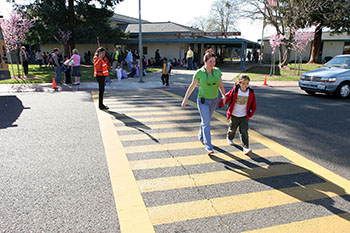School Siting Strategy Paper
School Siting Strategy Report Summary
 Often the price of land is the most critical factor influencing where a school is built. Typically, there isn't the type of alternatives analysis that would enable various sites to be compared with one another to determine what the best location both is in the near and long term. More attention should be given to identifying how conducive a school is for walking or biking, how accessible and amenable a school might be for community uses, how a school fits into an overall comprehensive plan, etc., before purchasing land.
Often the price of land is the most critical factor influencing where a school is built. Typically, there isn't the type of alternatives analysis that would enable various sites to be compared with one another to determine what the best location both is in the near and long term. More attention should be given to identifying how conducive a school is for walking or biking, how accessible and amenable a school might be for community uses, how a school fits into an overall comprehensive plan, etc., before purchasing land.
Since 2002, roughly the same amount of money has been allocated for school construction and road construction within the region. With an investment of this magnitude more emphasis should be placed on reducing congestion, improving air quality, and increasing walking and bicycling to school. Where a school is located is a key component to address these issues and many others.
Why is the location of a school so important?
- Nearly 25% of all trips during the morning commute in the Chicago region are school related.
- Nationwide the number of kids that walk or bike to school has fallen from nearly 50% in 1969 to less than 15% in 2001, while the number of automobile trips has increased from 17% to 49% of all school trips.
- Nationally, since 1980 childhood obesity has more than tripled.
- Once a school is built it will likely be in the same location in perpetuity.
A sample of findings:
- Increasing walking and bicycling trips to and from school can help provide more physical activity for students which would help to combat childhood obesity which have tripled since 1980.
- Almost 25% of commuting trips during the morning rush hour are school related. Reducing the amount of auto and bus trips by increasing the number of walking and bicycling trips would improve air quality near schools.
- Buses and cars idling near schools during pick-up and drop-off times contribute to air pollution and to increased health risk such as asthma. By increasing the number of students walking and bicycling the number of busses and auto trips can be reduced, thus reducing congestion and improving air quality.
- A joint commission, comprised of municipal and school district leaders from throughout the region, should be formed to examine land/cash ordinances to determine and evaluate how they are working and how they can be improved.
- Minimum acreage requirements for schools need to be reexamined, particularly at the high school level. It is not uncommon now to have high school campuses that are 75+ acres. The question of how many acres are necessary needs to be examined and recommendations need to be put forth to help guide the process.
|
Links |